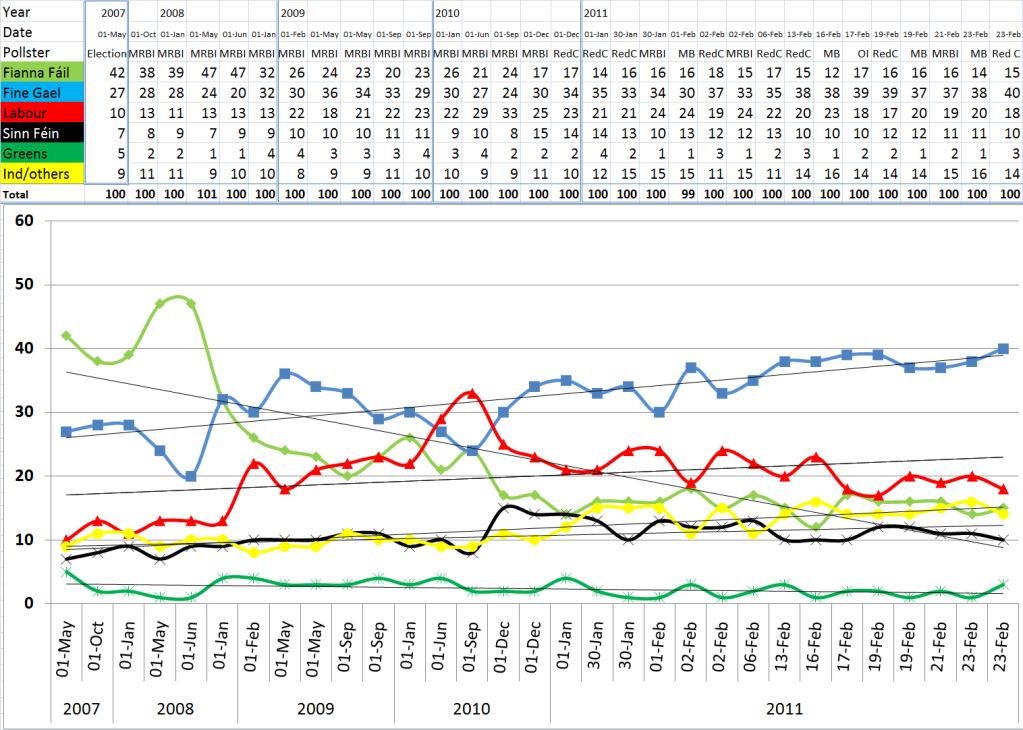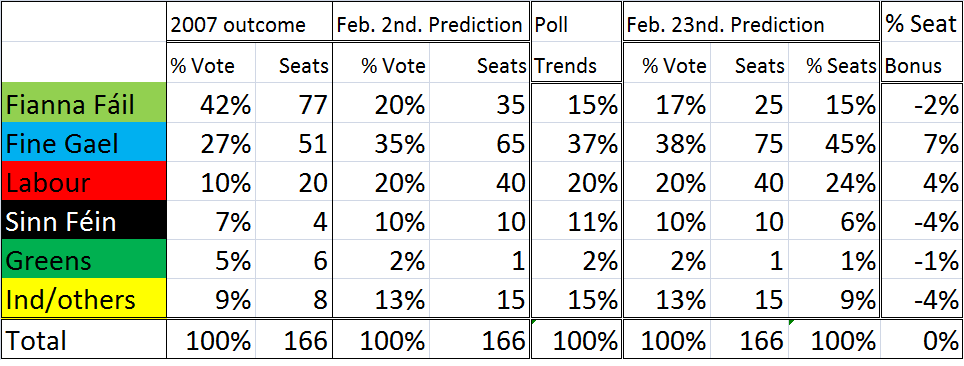Voting in the Irish General Election takes place on Friday (25th. Feb.) and the votes will be tallied and counted on Saturday. Some close counts may result in recounts which will probably take place on Sunday. By Monday we should know the overall strengths of all the parties and independents and these numbers will, in large part, determine the shape of the next Government.
At the moment it looks like there are only two realistic options being presented to the Irish electorate: A Fine Gael Labour coalition, or a minority Fine Gael Government with the support of right leaning Independents. The latter only really becomes an option if Fine Gael achieve a historic high of at least 75 seats, which, combined with c. 9 right leaning Independents would yield a total of 84 seats – sufficient for a bare majority in a 166 member Dail.
Whether Fine Gael would wish to form a Government with such a bare majority dependent on some possibly quite flaky Independents is open to question. A coalition with Labour would offer a huge majority which might last for more than one term. However Fine Gael might not wish to make the compromises on policy and the share out of Cabinet positions such a coalition would entail.
Labour strategists taking a longer view might also prefer to see Fine Gael bear the full brunt of unpopularity arising out of their austerity plans and settle for leading the Opposition and preventing Fianna Fail from exploiting the divisions in the Labour base that implementing such plans would undoubtedly create. However all such speculation is somewhat moot at this point until we see whether Fine Gael manages to achieve 75 seats.
So how have the party campaigns been going and what predictions can we make based on the opinion poll evidence?
Fine Gael has been on an upward trend in the polls rising from c. 33 to 40% since he election was called, whilst Labour declined from c. 24% to 18%. There have been various interpretations of these trends, but perhaps the most credible is that Labour has been squeezed between Left and Right. On the left by Sinn Fein and the United Left Alliance (contained within the Independents numbers) who advocate defaulting on banking debt, and on the right by Fine Gael who have taken up the renegotiation of the IMF/ECB deal refrain and have leveraged their alleged good relations with their EPP colleagues in the EU to make such a renegotiation look more feasible. There really isn’t much of a middle ground you can take up between these two positions.
Fianna Fail has flat-lined in the 12-18% range and hasn’t really achieved any “bounce” on the election of their new leader. This is despite the fact that Michael Martin has performed impressively in the campaign and is now the most popular party leader. Trying to campaign on the basis of the performance of the current Government really is flogging a dead horse which no admission of “some mistakes” can overcome. The worrying thing is that, even against such an unpromising background, Martin has managed to make the Fine Gael Leader, Enda Kenny, look decidedly stupid. We really could be about to elect an even worse Government. IS THIS POSSIBLE?
Sinn Fein has been flat-lining in the 10-13% range which will yield them a record number of seats. Their lack of credible spokespersons and Gerry Adam’s lack of grasp of economics have hampered their prospects of further progress. The Greens have flat-lined at 1-2%, and their only chance of winning one or more seats is if one or more of their candidates manage to buck the national trends due to extraordinary personal and local popularity.
Independents have maintained an historically high level of support in the 11-16% range despite the fact that the focus of the campaign has been very much on national economic policy issues – an area where independents have generally had very little influence. They are split roughly 50:50 between left leaning and right leaning candidate – a mix of hard left, conservative, local populist, managerial and political reform candidates, but it is also possible that those numbers hide quite a few “shy Fianna Failers” who cannot bring themselves to declare support for the Fianna Fail party as such, but who will nevertheless end up voting for Fianna Fail candidates with strong local brands and personal support.
So what is the likely outcome if these polling numbers accurately reflect voter behaviour on Friday? The table below compares the actual outcome of the 2007 general election with my predictions at the start of the campaign and my current view of the likely outcome.

My predictions in the table are based on a number of factors:
- Opinion poll trends as calculated using Kalman Filtering and Backwards Smoothing by Kevin O’Sullivan
- A 2% uplift for the Fianna Fail vote based on a “shy FF voter” effect (balanced by a 2% reduction in Independents vote)
- A 1% uplift for Fine Gael balanced by a 1% reduction in Sinn Fein vote due to differential voter turnout. (Predominantly middle class Fine Gael voters have historically had higher turnouts than working class Sinn Fein voters).
- Fine Gael and Labour to get 7 and 4% seat bonuses respectively (slightly higher % of total seats compared to total votes) due to the bonus that larger parties tend to get under the Single Transferable Vote system and the fact that polls show Labour and Fine Gael being much more “transfer friendly” than other parties – i.e. getting a higher proportion of lower preference votes from voters giving their first preference votes to other candidates.
- Conversely, Fianna Fail, Sinn Fein and Independents will gain a disproportionately smaller share of seats (compared to % vote) due to being smaller, more diverse, and less transfer friendly for lower preference votes. Fianna Fail will also suffer more seat losses due to running too many (incumbant) candidates and thus failing to manage their vote effectively. This is the phenomenon whereby candidates of the same party typically only transfer perhaps 75% of their vote between each other on elimination. The other 25% being either non-transferable (no further voter preference indicated) or transferred to another party resulting in the headline first preference total overstating the final effective vote for the party.
- The Greens are odds against winning a seat in any constituency based on these numbers, but I have allocated them one seat based on the possibility that one of their candidates will do extraordinarily well – possibly ex-Leader, Trevor Sargent, in Dublin North.
Perceptive readers will notice that I have rounded the seats predicted for each party to multiples of 5 because to try to predict exact seat numbers based on the vagaries of the single transferable vote system in 43 separate constituencies would be an exercise in spurious accuracy. Even as things stand I could be wildly out in my prediction if there is even a slight swing in the last few days of this campaign.
The significance of a result per my prediction is that it places Fine Gael right on the cusp of where a minority Fine Gael government might just be possible – 75 seats plus c. 8 right leaning independents resulting in 83 seats – exactly half the 166 seat chamber. In practice I think Fine Gael would regard that result too precarious to form a stable Government and would therefore seek a coalition arrangement with Labour. However every additional seat Fine Gael or sympathetic right leaning Independents get would make the prospect of a Fine Gael minority Government more feasible and likely.
Boards.ie has run an interesting simulation of the actual election based on the votes of 20,000 on line voters on their site – each registering for a specific constituency and voting for each candidate in order of preference – as in the real election. This allows them to factor in the transfer patterns based on lower preference votes and currently yields the following results:
Fine Gael 31% vote (64 seats)
Labour 22% vote (46 seats)
Fianna Fail 8% vote (3 seats)
Sinn Fein 12% vote (24 seats)
Greens 5% vote (4 seats)
Independents/others 22% vote (25 seats)
Obviously this result is not based on a random sample and tells us more about the particular views of Boards.ie users than it does about the general population. However 20,000 votes is a not insignificant sample and probably does give a good indication of the Irish blogosphere as a whole – heavily biased against Fianna Fail which has a much older age profile than other parties. The site does not appear to control for IP address so there is nothing to prevent Eurotrib readers logging in and voting in a constituency of their choice (and several times in several constituencies if they are so minded!). For those interested in experiencing at first hand how the Single Transferable Vote system works, filling out a simulated on line ballot paper there gives you an interesting introduction into the subject.
Paddy Power also gives betting odds for each candidate in each constituency. As Paddy Power has commissioned several constituency level polls and also has the experience of where punters are putting their money, those odds probably give as good an indication as any of how individual candidates will fare in each constituency.
I will try and do a bit of live blogging either here or on an open thread as the results come in on Saturday. The whole process of predicting, tallying and counting votes is one of the key ceremonies of Irish politics and is a fascinating exercise in popular democracy for nerds like me. An attempt to computerise the process proved to be a disastrous failure for the outgoing Government. It cost c. €100M and never produced a satisfactory audit trail to prove that no tampering had taken place. So the whole system has been thrown out – and all the voting machines are still in expensive storage somewhere in the south of Ireland.
Given the US experience of suspected vote tampering by Diebold I am glad the Irish attempt to computerise the process failed. Democracy is above all a community process which should be overseen at each stage by the whole community. The intricacies of local transfer patterns provide endless fascination for the local nerds and cognoscenti and is a vital part of the experience of democracy.




